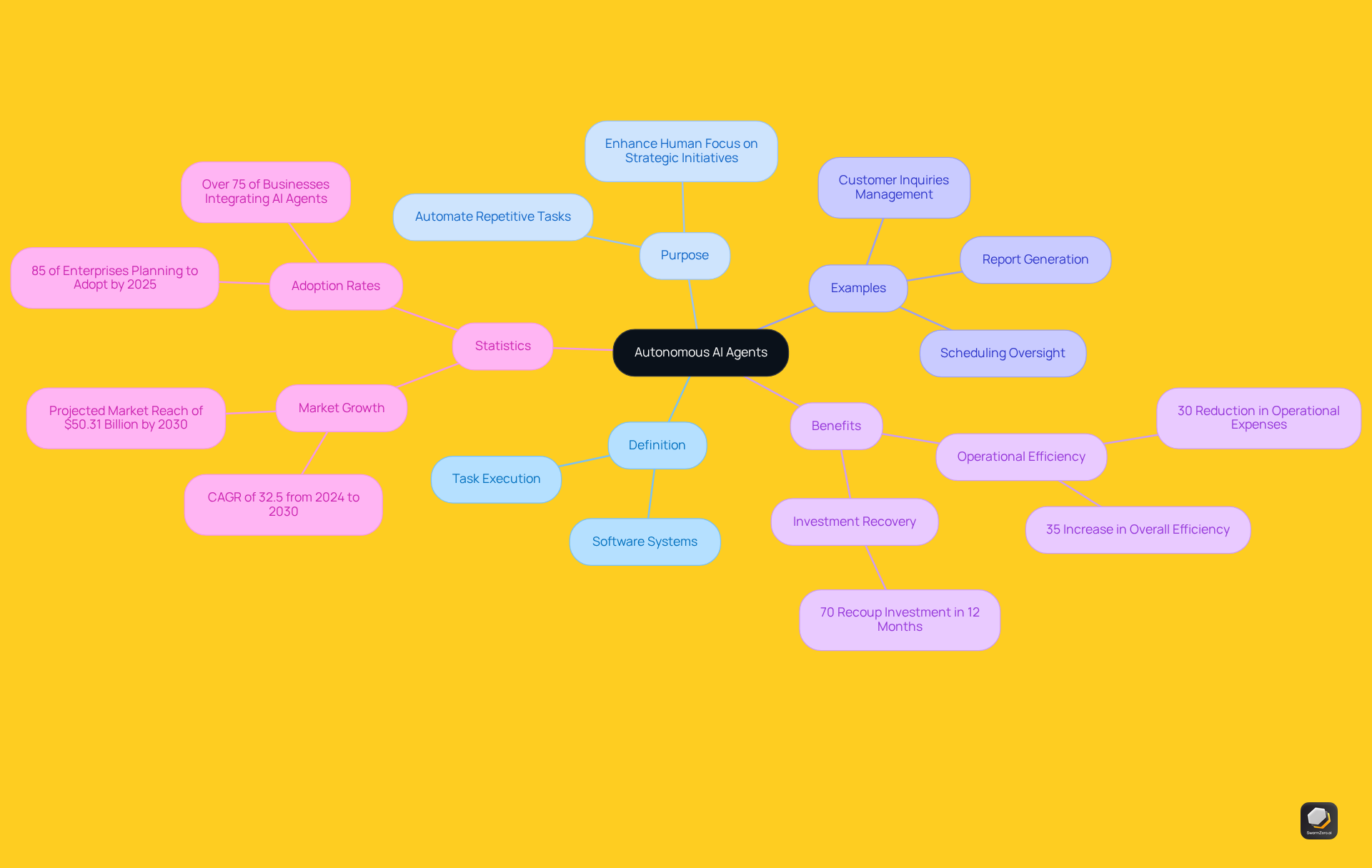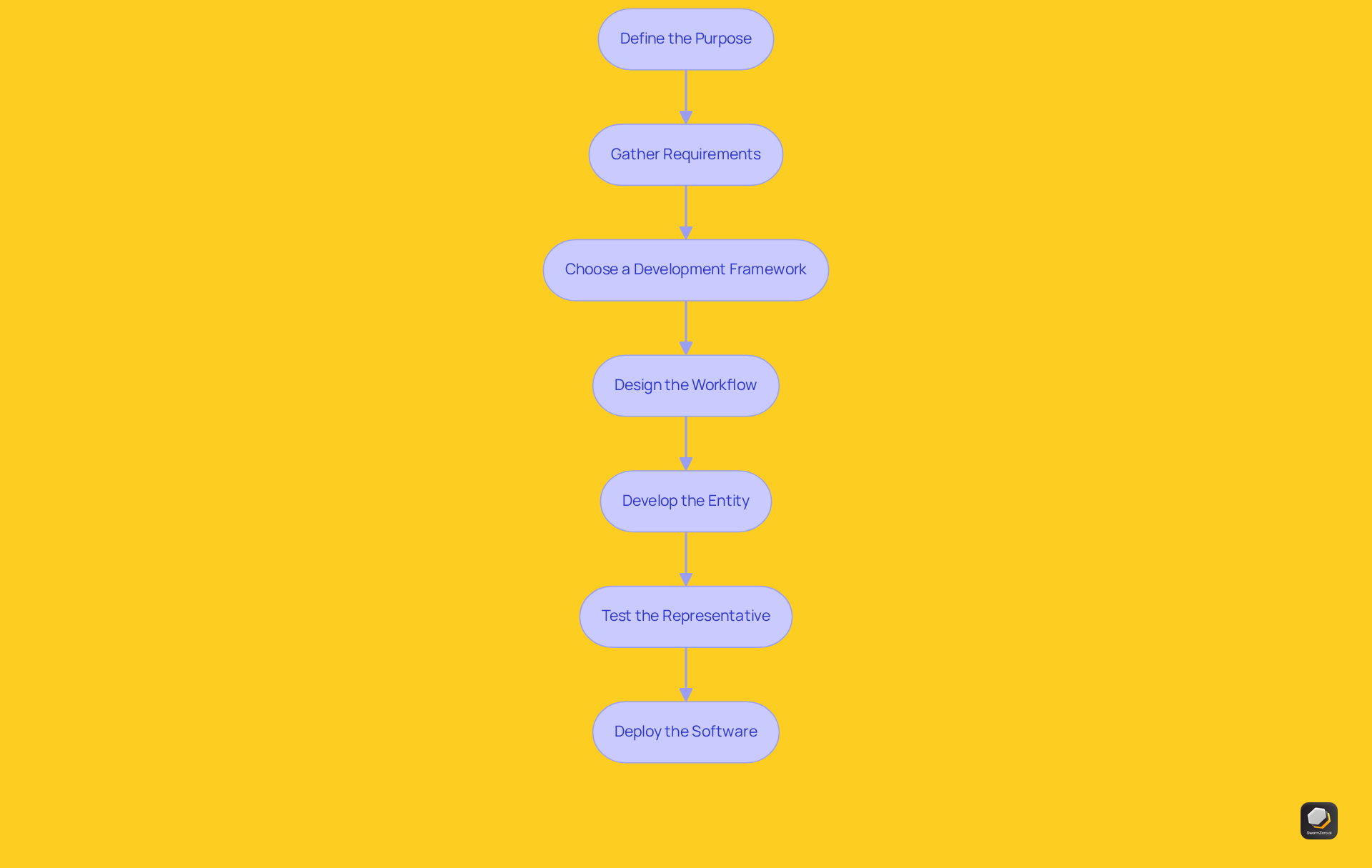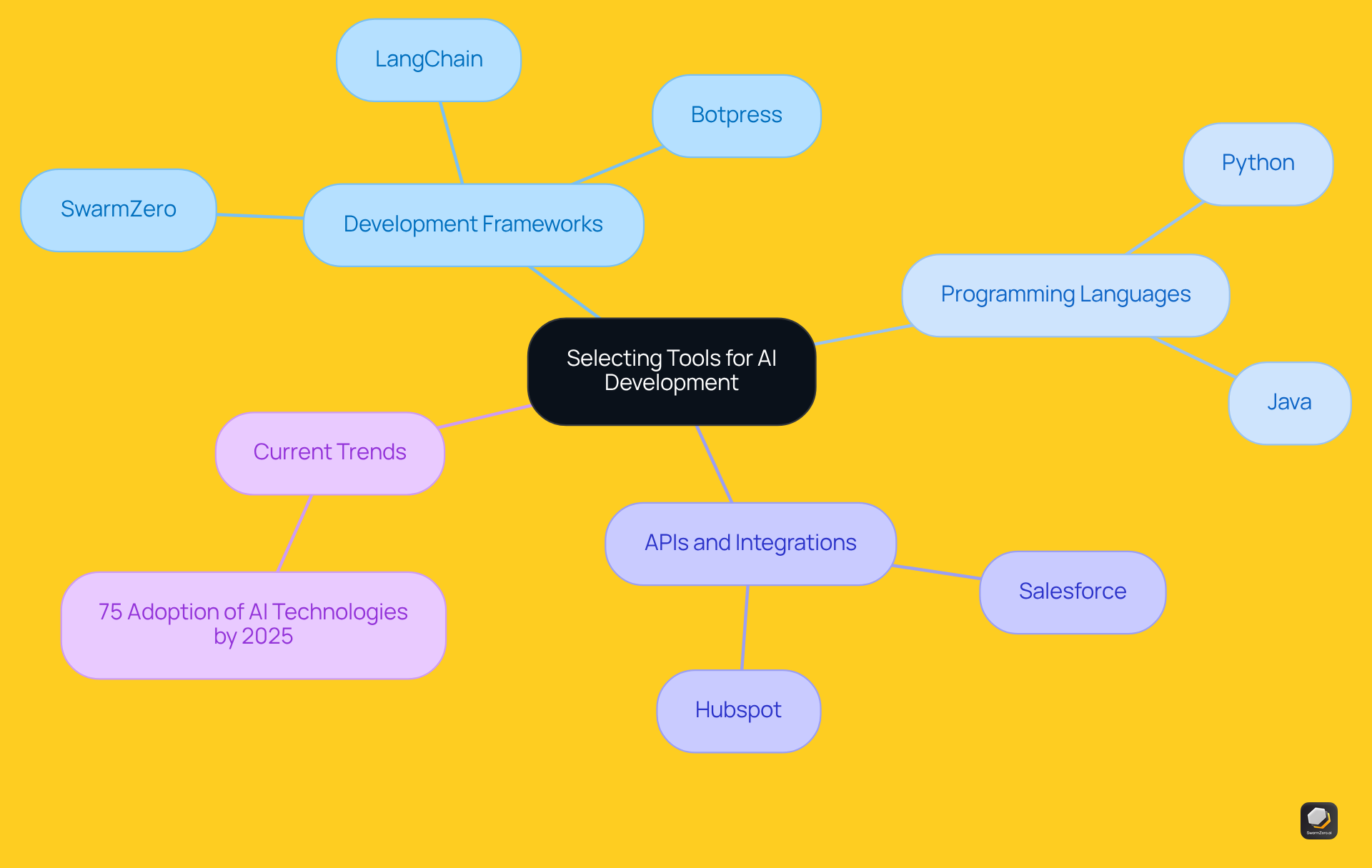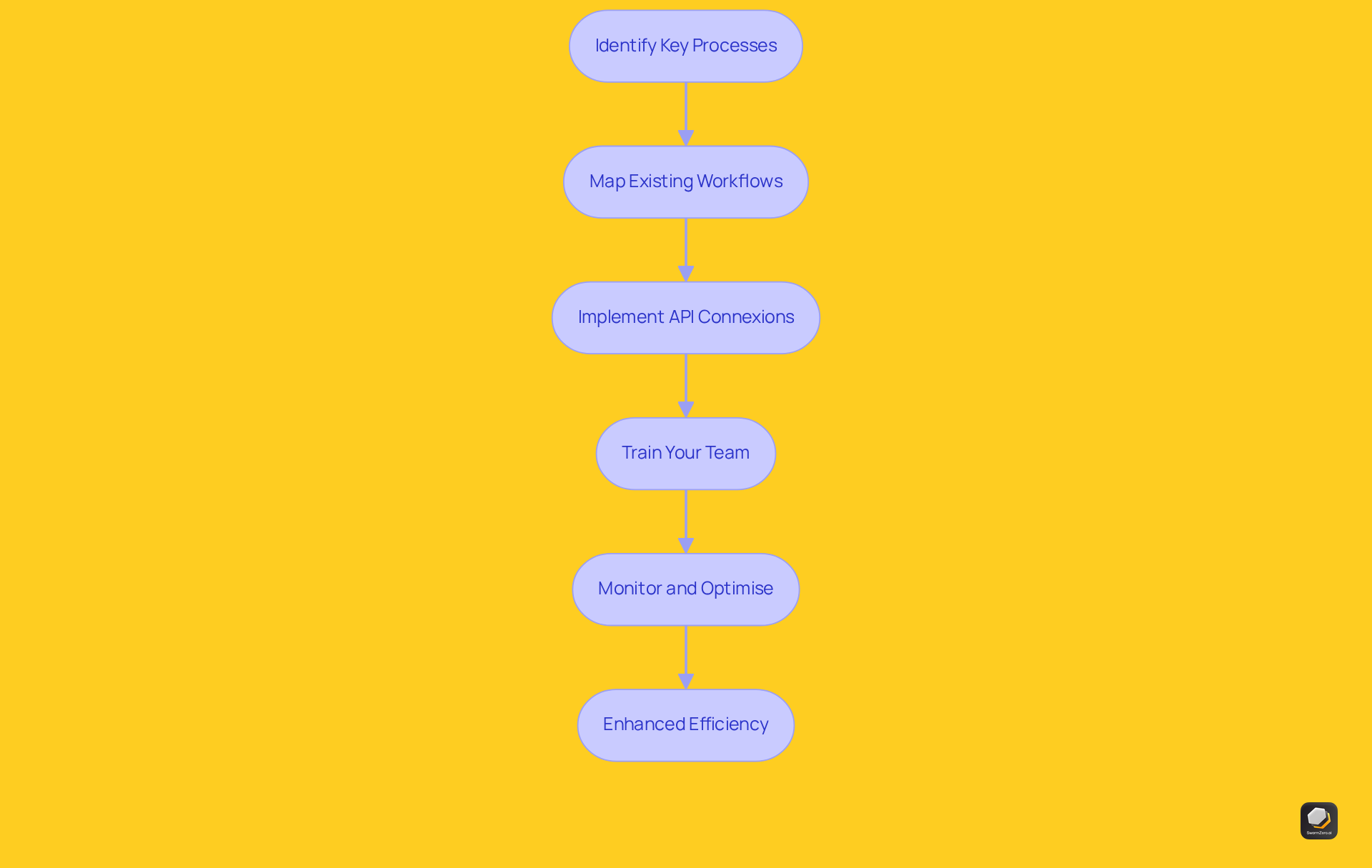How to Build an Autonomous AI Agent: A Step-by-Step Guide
Learn how to build an autonomous AI agent to automate tasks and enhance business efficiency.

Key Highlights:
- Autonomous AI agents execute tasks independently, enhancing operational efficiency and reducing costs for businesses.
- Built on frameworks like SwarmZero, these agents automate repetitive tasks, allowing human employees to focus on strategic initiatives.
- Companies using AI systems report a 30% reduction in operational costs and a 35% increase in efficiency.
- The development process involves defining purpose, gathering requirements, choosing frameworks, designing workflows, and deploying the software.
- Key tools for development include frameworks like SwarmZero, programming languages such as Python and Java, and APIs for integration with existing systems.
- Successful integration of AI agents into business workflows requires identifying key processes, mapping existing workflows, implementing API connexions, training teams, and continuous monitoring.
- As of 2025, Python is projected to dominate AI development, with 75% of enterprises expected to adopt AI technologies.
Introduction
Understanding the intricacies of autonomous AI agents is essential in an era where businesses are increasingly reliant on technology to streamline operations and enhance productivity. These intelligent systems are designed to perform tasks independently, freeing human employees to focus on strategic initiatives. However, the journey to building an effective autonomous AI agent is fraught with challenges. What are the essential steps to ensure success in this complex development process?
Define Autonomous AI Agents and Their Purpose
Understanding how to build an autonomous AI agent is crucial, as these entities represent a significant advancement in software systems, designed to execute tasks independently by leveraging their programming and environmental data to make informed decisions.
Built on the SwarmZero framework, these entities primarily focus on how to build an autonomous AI agent that automates repetitive tasks, thereby allowing human employees to concentrate on more strategic initiatives.
For example, an autonomous AI system can efficiently manage customer inquiries, generate reports, or oversee scheduling without requiring human oversight. This capability not only enhances operational efficiency but also substantially lowers expenses, positioning these representatives as essential across various business sectors, including marketing, sales, and customer service.
Companies that have integrated AI systems report a remarkable 30% reduction in operational expenses and a 35% increase in overall efficiency. Moreover, 70% of organisations recoup their investment in AI systems within just 12 months, underscoring their critical role in modern business operations.
As more organisations adopt these technologies, the importance of AI systems in streamlining processes and improving customer interactions becomes increasingly evident.
The Tavily API further enhances the functionality of these AI systems by providing advanced web search features, facilitating more efficient information retrieval and processing. This integration is crucial as AI continues to assume a pivotal role in customer interactions.

Outline the Step-by-Step Process for Building an AI Agent
-
Define the Purpose: Begin by clearly identifying how to build an autonomous AI agent to handle specific tasks. This could include automating customer service responses, generating personalised sales proposals, or managing inventory. A well-defined purpose is crucial; 85% of organisations using AI report enhanced productivity through focused applications, illustrating how to build an autonomous AI agent effectively.
-
Gather Requirements: Assess the necessary data inputs, outputs, and integrations with existing systems. Understanding these requirements is essential for seamless functionality. For instance, companies that effectively incorporate AI systems into their workflows report operational cost reductions of up to 30%.
-
Choose a development framework to effectively learn how to build an autonomous AI agent by selecting an appropriate platform for constructing your AI system. SwarmZero, for instance, offers an intuitive Creator that streamlines the development process, enabling users to design personalised entities suited to their particular requirements.
-
Design the Representative's Workflow: Outline the representative's workflow, detailing decision points and actions based on various inputs. This step is essential; knowing how to build an autonomous AI agent can greatly improve the individual's efficiency and effectiveness in practical applications.
-
Develop the Entity: Utilise the chosen framework to code the entity, incorporating machine learning models as needed. Current trends indicate that organisations that understand how to build an autonomous AI agent see a 61% increase in productivity by automating repetitive tasks.
-
Test the Representative: Conduct comprehensive testing to ensure the representative performs as expected across different scenarios. Testing is critical; 76% of businesses raise concerns about data security and performance reliability when implementing AI solutions.
-
Deploy the Software: After successful testing, implement the software within your business environment and continuously monitor its performance. Effective deployment can lead to significant improvements in operational efficiency, with some retailers experiencing a 72% reduction in operating costs through AI integration.

Select Appropriate Tools and Technologies for Development
When selecting tools for building an autonomous AI agent, consider the following:
- Development Frameworks: Platforms such as SwarmZero, Botpress, and LangChain are distinguished by their user-friendly interfaces and robust capabilities, making them ideal for creating AI agents efficiently. This platform, in particular, serves as a comprehensive AI marketplace, enabling users to create, profit from, and automate business solutions effectively. Its integration with the Tavily API enhances search functions, facilitating AI-driven processing that can significantly improve the representative's performance. Notably, this platform offers features such as advanced analytics and user engagement tools, which are particularly beneficial for marketing managers seeking to refine their strategies.
- Programming Languages: Python continues to be the premier choice for AI development, celebrated for its extensive libraries like TensorFlow and PyTorch that streamline machine learning and deep learning applications. Its simplicity and readability render it accessible for both novice and experienced developers. Java also stands out as a strong contender, especially for more complex applications that demand robust performance and scalability. By leveraging SwarmZero, these languages can be effectively utilised to enhance the functionality of the entity.
The integration of machine learning models is essential for learning how to build an autonomous AI agent, tailored to your entity's specific purpose. Frameworks such as TensorFlow and PyTorch not only support the development of sophisticated models but also bolster the agent's learning capabilities, enabling it to adapt and improve over time. SwarmZero's architecture facilitates the seamless integration of these models, ensuring optimal performance.
- APIs and Integrations: It is crucial to select tools that can seamlessly integrate with existing systems, such as CRM platforms or data sources. This capability is vital for enhancing the system's functionality and ensuring effective operation within your organisation's ecosystem. The ability to connect with platforms such as Salesforce and Hubspot can significantly boost the representative's efficiency and optimise workflows, particularly when utilising its features.
- Current Trends: As of 2025, Python is projected to dominate AI development, with approximately 75% of enterprises adopting AI technologies for various applications. This trend emphasises the necessity of selecting the right programming language and framework to remain competitive in the evolving landscape of AI. By utilising SwarmZero, marketing managers can ensure they are at the forefront of these developments and learn how to build an autonomous AI agent that crafts efficient AI solutions to meet their business needs.

Integrate AI Agents into Business Workflows for Maximum Efficiency
To effectively integrate AI agents into your business workflows, consider the following steps:
- Identify Key Processes: Focus on processes that can significantly benefit from automation, such as customer support, data entry, and lead generation. Research indicates that automating repetitive tasks can save substantial labour time and improve overall efficiency. Notably, Microsoft reported a 9.4% rise in revenue per seller by utilising AI tools in their sales function.
- Map Existing Workflows: Conduct a thorough analysis of current workflows to pinpoint bottlenecks and areas ripe for improvement. Engaging key stakeholders during this phase can provide valuable insights into practical automation opportunities. Genuine buy-in from all levels of staff is crucial for successful implementation, as highlighted by industry experts.
- Implement API Connexions: Utilise APIs to seamlessly connect your AI representatives with existing systems, ensuring smooth data flow and communication. This integration is essential for maximising the effectiveness of your AI systems.
- Train Your Team: Educate your team on collaborating with AI systems, highlighting the benefits of automation. A well-informed team can leverage AI capabilities to enhance productivity and focus on more strategic tasks. As Jessica Day noted, "If some of these can be handed to RPA bots instead, this leaves human staff with more time on their hands, which they can then put to other uses."
- Monitor and Optimise: Continuously track the performance of your AI systems and solicit feedback to make necessary adjustments. This iterative process ensures that your AI solutions evolve alongside your business needs, maintaining their relevance and effectiveness. Acknowledging that trial and error is a natural part of implementing automation will prepare your organisation for potential challenges.
By following these best practises, organisations can discover how to build an autonomous AI agent to streamline operations and enhance efficiency, ultimately leading to improved productivity and reduced operational costs.

Conclusion
The development of an autonomous AI agent signifies a transformative leap in business operations, enabling the automation of repetitive tasks and the optimisation of workflows. By harnessing advanced technologies and frameworks such as SwarmZero, organisations can forge intelligent systems that not only boost efficiency but also significantly lower operational costs. The journey to creating these agents necessitates a clear understanding of their intended purpose, meticulous planning, and careful integration into existing business processes.
This article delineates a comprehensive step-by-step process for crafting an autonomous AI agent, from defining its purpose and gathering requirements to selecting the appropriate tools and technologies. Crucial insights highlight the significance of employing suitable development frameworks, programming languages, and APIs to ensure seamless functionality. Moreover, integrating AI agents into business workflows can yield substantial productivity enhancements, as evidenced by the positive outcomes reported by organisations that have adopted these technologies.
As the AI landscape continues to evolve, the potential for autonomous AI agents to revolutionise business operations is indisputable. Organisations are urged to explore the construction of these agents, not merely as a strategy to keep pace with technological advancements but as a strategic initiative that can confer significant competitive advantages. By embracing automation and investing in the right tools, businesses can position themselves for success in an increasingly automated future.
Frequently Asked Questions
What are autonomous AI agents?
Autonomous AI agents are software entities designed to execute tasks independently by leveraging their programming and environmental data to make informed decisions.
What is the primary purpose of building autonomous AI agents?
The primary purpose is to automate repetitive tasks, allowing human employees to focus on more strategic initiatives, thereby enhancing operational efficiency and reducing costs.
Can you provide examples of tasks that autonomous AI systems can handle?
Autonomous AI systems can efficiently manage customer inquiries, generate reports, and oversee scheduling without requiring human oversight.
What impact do AI systems have on operational expenses and efficiency?
Companies that have integrated AI systems report a 30% reduction in operational expenses and a 35% increase in overall efficiency.
How quickly can organisations expect to recoup their investment in AI systems?
About 70% of organisations recoup their investment in AI systems within just 12 months.
Why are autonomous AI agents becoming increasingly important in business?
As more organisations adopt these technologies, AI systems play a critical role in streamlining processes and improving customer interactions.
What is the Tavily API and how does it relate to autonomous AI agents?
The Tavily API enhances the functionality of AI systems by providing advanced web search features, facilitating more efficient information retrieval and processing, which is crucial for customer interactions.
List of Sources
- Define Autonomous AI Agents and Their Purpose
- 25+ AI Agent Statistics Mirroring the 2025 Market! (https://experro.com/blog/ai-agent-statistics)
- AI Agents Statistics: Usage And Market Insights (https://litslink.com/blog/ai-agent-statistics)
- Gartner Predicts Agentic AI Will Autonomously Resolve 80% of Common Customer Service Issues Without Human Intervention by 2029 (https://gartner.com/en/newsroom/press-releases/2025-03-05-gartner-predicts-agentic-ai-will-autonomously-resolve-80-percent-of-common-customer-service-issues-without-human-intervention-by-20290)
- 150+ AI Agent Statistics [July 2025] (https://masterofcode.com/blog/ai-agent-statistics)
- AI Agents Statistics & Market Trends For 2025: Growth & Impact (https://allaboutai.com/ai-agents/statistics)
- Outline the Step-by-Step Process for Building an AI Agent
- 15+ AI Agents Statistics You Need to Know in 2025 (https://azilen.com/blog/ai-agents-statistics)
- AI Agents Market Size & Trends, Growth Analysis, Forecast [2030] (https://marketsandmarkets.com/Market-Reports/ai-agents-market-15761548.html)
- 200+ AI Agent statistics for 2025 (https://pragmaticcoders.com/resources/ai-agent-statistics)
- AI Agents Statistics & Market Trends For 2025: Growth & Impact (https://allaboutai.com/ai-agents/statistics)
- 150+ AI Agent Statistics [July 2025] (https://masterofcode.com/blog/ai-agent-statistics)
- Select Appropriate Tools and Technologies for Development
- Why Python is a Very Popular Language for AI in 2025 (https://iqlance.com/why-python-popular-language-for-ai)
- Top 40 AI Stats in Software Development in 2025 You Won't Believe (But Need to Know) (https://softura.com/blog/ai-powered-software-development-statistics-trends)
- Top Programming Languages for AI Development (https://linkedin.com/pulse/top-programming-languages-ai-development-next-big-technology-c85bc)
- Top 6 Programming Languages for AI - Software Mind (https://softwaremind.com/blog/6-best-programming-languages-for-artificial-intelligence)
- Top 8 Languages For Artificial Intelligence - BairesDev (https://bairesdev.com/blog/top-languages-for-ai)
- Integrate AI Agents into Business Workflows for Maximum Efficiency
- AI, automation, and the future of work: Ten things to solve for (https://mckinsey.com/featured-insights/future-of-work/ai-automation-and-the-future-of-work-ten-things-to-solve-for)
- How to identify processes you should automate | Startups Magazine (https://startupsmagazine.co.uk/article-how-identify-processes-you-should-automate)
- Agentic Artificial Intelligence Quotes by Pascal Bornet (https://goodreads.com/work/quotes/240795611-agentic-artificial-intelligence-harnessing-ai-agents-to-reinvent-busine)
- AI Agents: The Next Evolution of Work | Yula Studio (https://linkedin.com/posts/yula-studio_10-quotes-on-ai-agents-from-the-top-industry-activity-7313562573260357632-yMS-)
- 35 AI Quotes to Inspire You (https://salesforce.com/ca/artificial-intelligence/ai-quotes)




